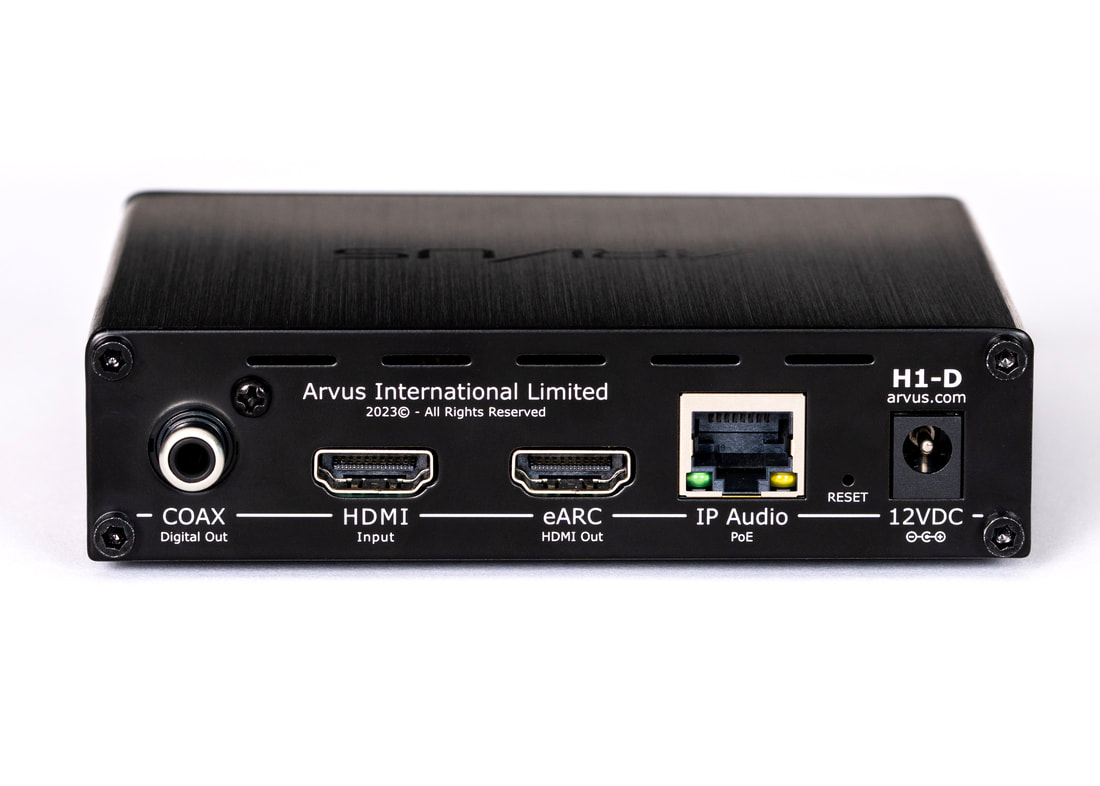H1-D
The world's first multi-codec spatial audio HDMI converter for Audio over IP

USD3,250.00 each
Answer our 'use case questionnaire' to qualify for a 10% discount
shipping soon
PRIMARY FEATURES
CONVERT HDMI AUDIO TO:
- AES67 (up to 16 Channels)
- DANTE® (up to 16 Channels)
- BINAURAL - Analog & Digital (2 Channels)
DECODE / RENDER
- DOLBY - Atmos®, Dolby Digital, Dolby Digital Plus, Dolby TrueHD, Dolby Surround, Dolby Vision (passthrough)
- DTS - DTS-X®, ES, HD Master Audio, IMAX Enhanced, HD High Resolution Audio, Express-HD LBR, Neural:X
- AURO-3D
- MPEG-H
- 360 Reality Audio
- PCM - 2ch, PCM Multi-channel, Downmix

|
INPUTS
|
OUTPUTS
|
ADDITIONAL FEATURES
- Linux / Shark platform architecture
- HDMI v2.1
- 4 function IR remote control
(power, mute, volume-up, volume-down) - 16 & 24 bit compatible
- Decodes up to 16 channels at:
- up to 24 bit / 48kHz (for Dante)
- up to 24 bit / 96kHz (for AES67)
- Digital COAX - up to 24 bit / 192kHz (2 channel)
- Variable Digital Output (AES67/Dante and COAX) controlled via GUI / Network / IR
- Manual Volume control assignable via GUI for Headphone or AoIP output
- ARC & eARC support
- ARC & eARC Lip-sync delay
- HDMI 2.1 pass-through output
- Includes Power over Ethernet (PoE)
- GUI for system set up (via ethernet)
- Firmware upgrade over ethernet
- Object based rendering from 5.1.2 to 9.1.6
- HDMI OUT has EDID emulation for stable device communication
- Supported in Crestron system control
- Supplied with:
- Remote control
- 1M HDMI cable
- International power-supply
- The H1-D has a dedicated flash memory for a default firmware which cannot be changed. When the reset button is used the device reverts to the original Firmware
GUI SCREENSHOT

PHYSICAL FEATURES
- Tough extruded aluminum case, with metal panels.
- Front and rear air-slots for ventilation.
- Power switch and LEDs on the front panel.
- Inputs and outputs mounted on the back panel.
- Professional grade product for 24/7 operation
- External international power supply (100v/240v)
- Weight – 1kg / 2.2 Ibs
- 120mm W x 100mm D x 30mm H

PRODUCT BACKGROUND
After launching the H2-4D in late 2021 we were immediately inundated with requests to develop a more cost effective and simple HDMI to AES67 / DANTE® solution where small form-factor is required.
In June 2022 I decided to create a small focused team within Arvus and officially started the H1-D project. Over the following months we observed the Spatial Audio ecosystem evolve significantly, and thus we realised we needed to advance the H1-D design to enable full firmware upgrade-ability so it could meet future market needs. After extensive research, development and direct market engagement it became obvious that the H1-D needed to become a Linux / Shark based platform with a whole new firmware topology to allow feature and functional flexibility.
Parallel to this we physically engineered the H1-D to be a robust device plus we the designed its 'look' to be a touch retro and utilitarian to emphasise its commercial applications, while keeping it within the Arvus design language used currently.
All of us here at Arvus are very excited about the potential of the H1-D to be globally adopted to accelerate the use of Spatial Audio. Through firmware updates we aim the H1-D to continue to meet the progressing needs of the Spatial Audio revolution for many years to come.
In June 2022 I decided to create a small focused team within Arvus and officially started the H1-D project. Over the following months we observed the Spatial Audio ecosystem evolve significantly, and thus we realised we needed to advance the H1-D design to enable full firmware upgrade-ability so it could meet future market needs. After extensive research, development and direct market engagement it became obvious that the H1-D needed to become a Linux / Shark based platform with a whole new firmware topology to allow feature and functional flexibility.
Parallel to this we physically engineered the H1-D to be a robust device plus we the designed its 'look' to be a touch retro and utilitarian to emphasise its commercial applications, while keeping it within the Arvus design language used currently.
All of us here at Arvus are very excited about the potential of the H1-D to be globally adopted to accelerate the use of Spatial Audio. Through firmware updates we aim the H1-D to continue to meet the progressing needs of the Spatial Audio revolution for many years to come.
Matthew A. Simmons
CEO / Founder
CEO / Founder
